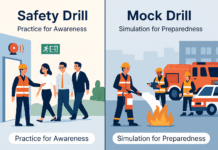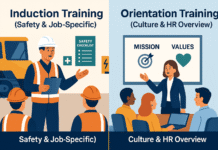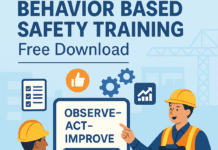
Safety Induction Topics: Ensuring a Secure Workplace
Safety Induction Topics : In the dynamic world of modern businesses, safety is paramount. Employers have a moral and legal obligation to ensure the safety of their employees. One effective way to achieve this is through a comprehensive safety induction program. In this article, we will delve into the key safety induction topics, their importance, and how to conduct an effective safety induction.
Key Safety Induction Topics
General Safety Guidelines
Safety induction begins with the basics. It covers essential safety rules that apply to all employees, regardless of their roles. These guidelines establish the foundation for a safe work environment.
Emergency Procedures
In case of accidents or unforeseen events, employees need to know how to respond. This section provides information on evacuation plans, first aid procedures, and who to contact in emergencies.
Safety Equipment and Usage
Proper handling of safety equipment is crucial. This section details the types of equipment available and how to use them effectively.
Workplace Hazards
Employees must be aware of potential workplace hazards. Identifying risks and taking preventive measures is part of creating a secure work environment.
Health and Hygiene
This topic covers the importance of personal health and hygiene in preventing accidents and maintaining a safe workplace.
Reporting Incidents
Encouraging employees to report incidents is vital. This section explains how to report accidents, near-misses, or unsafe conditions.
The Role of Employers
Providing a Safe Work Environment
Employers must create a safe environment for their employees. This includes ensuring that all safety measures are in place and are regularly maintained.
Legal Requirements
Compliance with safety regulations is mandatory. Employers must be aware of and meet the legal requirements related to safety in the workplace.
Training and Resources
Employers need to provide adequate training and resources to ensure that employees can carry out their duties safely.
The Role of Employees
Responsibility for Personal Safety
Employees have a responsibility for their own safety. This section emphasizes the importance of adhering to safety guidelines.
Reporting Safety Concerns
If employees identify safety concerns, they should report them to the relevant authority promptly.
Safety Induction Best Practices
Interactive Training Methods
Engaging and interactive training methods, such as simulations, can make the induction process more effective.
Regular Updates
Safety guidelines and procedures may change over time. Regular updates to the induction program are necessary to keep employees informed.
Documentation
Maintaining records of safety inductions helps in tracking employee progress and compliance with safety guidelines.
Benefits of Effective Safety Induction
A well-executed safety induction program has several benefits. These include a reduction in workplace accidents, improved employee morale, and adherence to legal requirements.
How to Conduct a Safety Induction
Planning and Preparation
Proper planning is essential for a successful safety induction. Employers should prepare the content and materials and schedule the training.
Effective Delivery
The delivery of safety induction is crucial. Trainers should be knowledgeable and skilled in engaging employees effectively.
Assessment and Feedback
Evaluating the effectiveness of the induction and seeking feedback from employees can help refine the process.
Measuring the Success of Safety Inductions
Tracking Incident Reports
Monitoring incident reports can indicate the impact of safety inductions on accident reduction.
Employee Feedback
Collecting feedback from employees can provide insights into the quality and effectiveness of the induction program.
Continuous Improvement
Continuous improvement is essential in the quest for a safer workplace. Regularly updating the safety induction program based on feedback and changing circumstances is vital.
Conclusion
In conclusion, safety induction is a critical component of ensuring a secure workplace. Employers and employees both play vital roles in maintaining safety. The proper planning and delivery of safety inductions, along with continuous improvement, contribute to a safer and more productive work environment.
Food Safety and Hygiene Training
Transport and Road Safety Training
Chemical Handling and Hazardous Materials Training
FAQs
1. Why is safety induction necessary? Safety induction is necessary to ensure that employees are aware of potential workplace hazards and know how to respond in emergencies, thus reducing accidents and creating a secure work environment.
2. What should be included in a safety induction program? A safety induction program should include general safety guidelines, emergency procedures, safety equipment usage, workplace hazards, health and hygiene, and reporting incident procedures.
3. How often should safety inductions be conducted? Safety inductions should be conducted for all new employees and should be regularly updated to ensure compliance with changing safety regulations.
4. Can safety inductions be tailored to specific industries? Yes, safety inductions can and should be tailored to specific industries to address industry-specific risks and requirements.
5. What are the consequences of not conducting safety inductions? Failure to conduct safety inductions can lead to an increase in workplace accidents, legal consequences, and a negative impact on employee morale.
























